CUMBRES & TOLTEC TRAIN (Day 2 - part 4)
Our trip included a lovely buffet lunch in the dining hall.

This building wasn't here in the old days. It wasn't built in 1988. Before then, passengers either ate on picnic tables outside or on the deck of the section house... not always convenient during afternoon storms.

Chose your line... but um... what about those of us who are vegetarians? Fortunately there was an unmarked line in the back for a salad bar.


The food was actually quite good... all homemade...
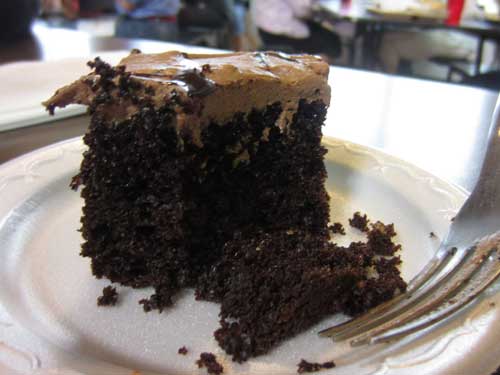
... including several scrumptious desserts!
I then took a short walk around the historic buildings until the train sounded four long blasts of its whistle, signaling its prompt departure.

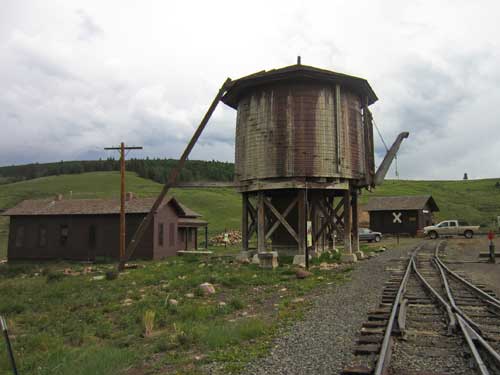
Gravity-fed water tanks were originally built about every 7-10 miles along the track (especially important when locomotives were much smaller) since a train can't hold enough water to provide steam power for an entire trip. This current one was constructed in 2000 in the same style as the first one built in 1880. It can hold 50,000 gallons and is fed from an underground spring.

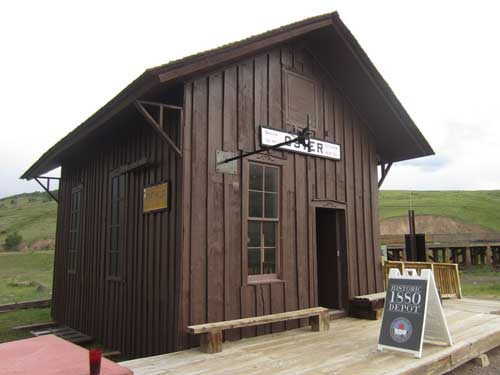
The station housed an office, waiting room and sleeping quarters. It was restored from 1995 - 2000. Inside, I spoke with a woman who had worked on the restorations. She told me that when they started, the station was sunken into the ground all the way up to its windows!


The restored interior
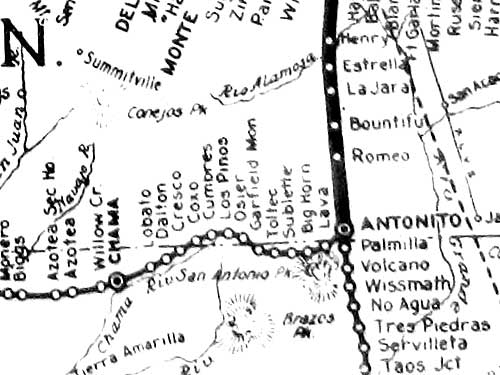
Stops along the railroad line. In the 1880's, it cost $20.30 to get here all the way from Denver and a good meal cost 75 cents. (Click for an extended view of the map)

This is all that remains of an extensive platform for loading and storing coal. It sits alongside a spur track that once led to a covered turntable (built in 1888 and removed in 1927).

While some earlier trains burned wood, locomotives on this line always burned soft coal. Coal burns more efficiently than wood and throws off fewer sparks.

An informative sign is all that's left of the turntable. Where space was available, trains turned either on a wye track or a loop track. Here, where there wasn't as much space, crews used giant turntables to rotate the locomotives. Amazing as it sounds, it was turned by hand.

The section house (much bigger than the one in Sublette) was built in 1888 and served as living quarters for railroaders stationed here... a foreman and his family, a station agent, and perhaps a few others. It was restored in 1993 - 2005.

Next to our train were several large livestock loading pens, built around 1936. From the 1880's until the 1950's, ranchers raised livestock up here and then used the trains to ship them down to Alamosa.

Engine No. 487 was built in 1925, weighs 187,000 pounds, and can carry 5,000 gallons of water and 9.5 tons of coal.

As we left the station, thunder and large bolts of lighting threatened, but no storm ever came. We promptly crossed over Cascade Creek Trestle. The original bridge was completed hastily in 1880, but a near derailment in 1881 caused it to be rebuilt in 1889. At 137 feet tall, its the highest on the line.

Looking back at the trestle

Following the Rio de Los Pinos River down the Los Pinos Valley. This large U-shaped valley was carved out by glaciers 10-15,000 years ago.

Faint traces of the old toll road from 1877 still remain.

Bovine tranquility
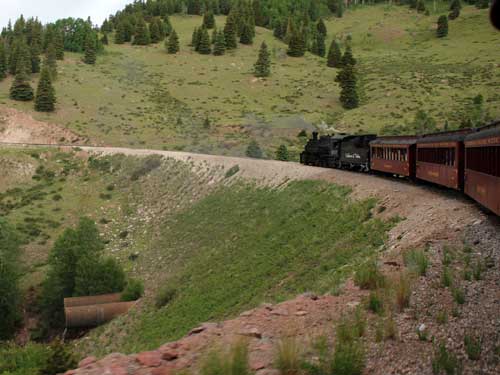
This section of the track used to be a trestle over Long Creek. It kept requiring a lot of repair, however, so this 'dirt bridge with water pipes through it' (more officially called a culvert) was built.


Approaching a small group of homes clustered at the back of the valley. Here the track doubled back on itself and made its way back along the other side of the valley.

The Los Pinos water tank was built in 1880 (rebuilt in 1986) and is fed from a well and reservoir nearby. This was also once the site of a coal house. Since this area is subject to gale-force winds and huge drifts of snow (20 to 30 feet high), extra coal was needed to refuel the rotary snowplows.

People frequently were gathered at the railroad crossings to watch the train pass.

A passing deer gets a face full of train smoke!
This tight 20 degree curve which climbs 39 feet of elevation was originally called Cumbres Loop or The Balloon by railroad crews. Eastbound crews would hop off the trains on the upper track, walk down to the lower track, inspect the passing cars for any burned out bearings, the hop back on the caboose. The story goes that many years ago, one trainman tangled his foot in a briar and slid down the bank almost into the path of his own train... hence the current name of Tanglefoot Curve.

The train is on the lower track with the upper track in view above it.
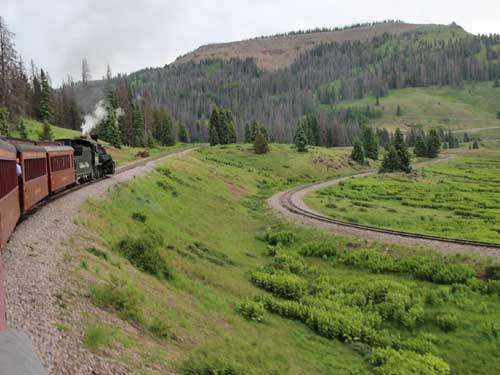
Having made the curve to the upper track, with the lower track also in view

We pulled into Cumbres Pass.With an elevation above 10,000 feet, it had gotten quite chilly and we all put on our jackets (and most people had also pulled up their windows). This was the highest point of our trip....and the highest pass reached by rail in the US. After a brief stop to take on water, we began our descent.

Highway 17 (the road the train is crossing) was built in 1969.
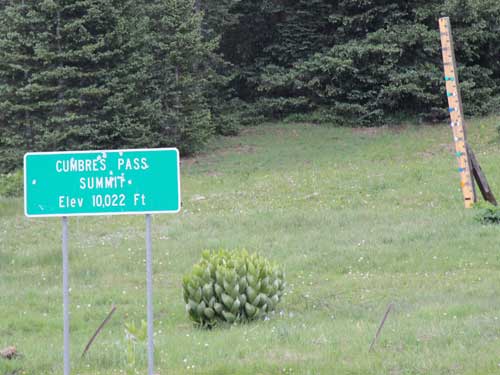
Cumbres means 'crest' or 'summit' in Spanish. In the background is a snow marker.

Fill 'er up!

Up on a hill was a tall water level gauge, which was connected to a float in the cistern.


Snowshed 330A was about 526 feet long and covered a wye. Due to lack of maintenance, most of the shed collapsed in the late 1970's. Pieces of it were rebuilt in 1990-91.
While snowsheds over tracks seemed like a good idea, they often didn't survive too long. Since they were exclusively made of wood, they burned quickly from stray embers as a train passed beneath them. This is the last surviving covered wye in the US and also the last standing snowshed along this track.

The original shed being built in 1916.
return • continue

